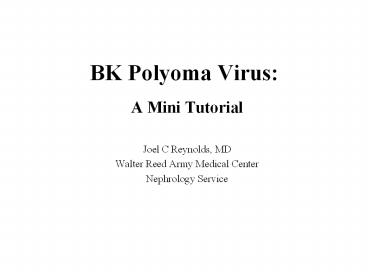BK Polyoma Virus: - PowerPoint PPT Presentation
Title:
BK Polyoma Virus:
Description:
Nephrology Service. What We Know: ... J Am Soc Nephrol. 2002 Aug;13(8):2145-51. ... of Mr. David Oliver and Mrs. Luana Kiandoli, Nephrology Laboratory, WRAMC ... – PowerPoint PPT presentation
Number of Views:624
Avg rating:3.0/5.0
Title: BK Polyoma Virus:
1
BK Polyoma Virus
- A Mini Tutorial
- Joel C Reynolds, MD
- Walter Reed Army Medical Center
- Nephrology Service
2
What We Know
- BKV seroprevalence is almost ubiquitous with over
90 of all people seropositive by age 10.1 - BKV nephropathy is a significant cause of renal
allograft loss.2 - Urine shedding of BKV is more prevalent than
viremia.1,2 - Primary infection with seroconversion has been
documented.1 - To date all studies have shown 100 urine PCR
positivity when viremia is present by PCR.1,2
3
What We Know
- BKV nephropathy can resemble acute rejection on
biopsy, usually unresponsive to steroids when
treated as rejection.3 - Allograft biopsy is currently considered the
gold standard for diagnosis, but has
questionable sensitivity.3 - BKV infected renal tubular epithelial (decoy)
cells appear to deteriorate quickly (within
minutes), which may limit urine microscopy as a
screening tool.4
4
What We Know
- Urine BKV DNA load is usually at least 105x
higher than serum viral DNA load and may be
present without viremia.5 - No studies to date have identified clear risk
factors which would help predict those at risk
for BKV nephropathy, to include tacrolimus,
mycophenolate, or steroids.2
5
What We Suspect
- Overall immunosuppression levels are too high.
- Prevalence is much higher than previously
suspected. - Antiviral drugs (cidofovir) may be effective
treatment.6 - Failure to detect BKV early leads to irreversible
nephropathy.4 - Allograft biopsy sensitivity for BKV is suspect
due to the spotty nature of early infection and
apparent predeliction of the virus for medullary
renal tissue.3
6
What We Dont Know
- Is there a reservoir for BKV other than urinary
tract? - What are the risk factors for developing BKVN?
- Risk factors for reactivation of harbored BKV?
- Does serology of donor/recipient change risk?
- What level of serum BKV DNA denotes those at
increased risk of progression to BKVN? - How does cidofovir (known to inhibit viral DNA
polymerase) inhibit BKV replication (which has no
DNA polymerase)?
7
What We Dont Know
- What is the most cost effective/sensitive test to
help predict those at increased risk for
developing BKVN? - Serum PCR, very sensitive (4 copies/ml),
expensive (200), significance of levels? - Urine PCR, very sensitive, expensive, not
specific, signficance of levels? - Urine decoy cell microscopy, inexpensive,
operator/time dependent, significance of positive
finding?
8
What Is Needed?
- Large, prospective trials including transplant
recipients not on calcineurin inhibitors, and on
steroid free protocols, to adequately assess for
risk factors which would predispose to infection
by BKV. - Likely would require multi-center cooperation to
achieve power to detect factors with significance
(similar to the studies of CMV status of
donor/recipient performed in the 70s).
9
References
- Hirsch HH, et.al. Prospective study of
polyomavirus type BK replication and nephropathy
in renal-transplant recipients. N Engl J Med.
2002 Aug 15347(7)488-96. - Ramos E, et.al. Clinical course of polyoma virus
nephropathy in 67 renal transplant patients. J Am
Soc Nephrol. 2002 Aug13(8)2145-51. - Drachenberg RC, et.al. Morphological spectrum of
polyoma virus disease in renal allografts
diagnostic accuracy of urine cytology. Am J
Transplant 2001 Nov1(4)373-81. - Personal observations in our clinic (Walter Reed
AMC). - Brennan DC, unpublished data, Washington Univ
School of Medicine, St. Louis, MO. - Vats A, et.al. Quantitative viral load monitoring
and cidofovir therapy for the management of BK
virus-associated nephropathy in children and
adults.Transplantation. 2003 Jan 1575(1)105-12. - Nickeleit V, et.al. BK virus infection after
kidney transplantation. Graft. 2002 Dec S18 (5)
S46-57.
10
A Pictorial Tutorial Unstained Freshly-Voided
Urine with Decoy Cells (Renal Tubular
Epithelial cells with BKV- Associated
Intranuclear Inclusions)
Digital photographs courtesy of Mr. David Oliver
and Mrs. Luana Kiandoli, Nephrology Laboratory,
WRAMC
11
Type I An amorphous ground-glass variant
Ground-glass appearance of nucleus
400x (Olympus BH2 microscope)
Reference 7
12
Type II granular variant surrounded by a halo
Reference 7
400x (Olympus BH2 microscope)
13
Type III a finely granular variant without halo
400x (Olympus BH2 microscope), Enlarged 1.6x in
processing image.
Reference 7
14
Type II/III hybrid
Intranuclear vesicles
400x (Olympus BH2 microscope), Enlarged 2x in
processing image.
Reference 7
15
Type IV a vesicular variant with clumped,
irregular chromatin
400x (Olympus BH2 microscope), Enlarged 2x in
processing image.
Reference 7

